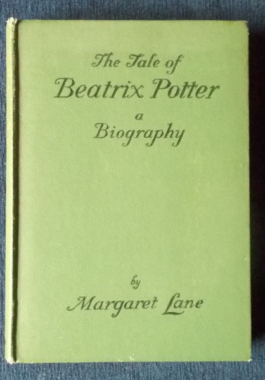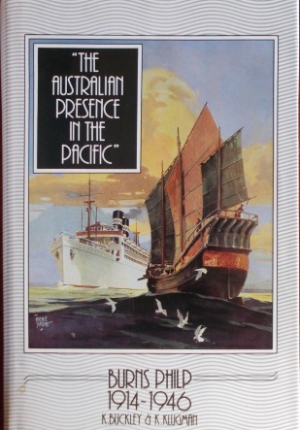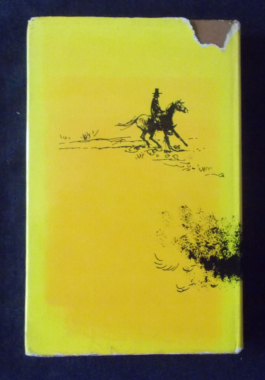-
 Beatrix Potter lived a modest, unsensational and private life. The first few decades were spent in being governess-taught at home and with few friends outside of her brother and extended family and in being the dutiful daughter. She loved to study nature and became a very good natural scientist - but by 1897, Beatrix was 31 and searching for more independent activities, wishing to earn some money of her own while dutifully taking care of her parents, dealing with her especially demanding mother as well as managing their various households. From painting natural botanical specimens she progressed to fantasy pictures of animals and thence to the book that became the classic Tale Of Peter Rabbit. And the rest - of course - is history. This biography was only made possible with the assistance of her family friends - the tale of the creator behind the perennial animal stories beloved by generations of children. Includes four colour plates and sixteen black and white photographs.
Beatrix Potter lived a modest, unsensational and private life. The first few decades were spent in being governess-taught at home and with few friends outside of her brother and extended family and in being the dutiful daughter. She loved to study nature and became a very good natural scientist - but by 1897, Beatrix was 31 and searching for more independent activities, wishing to earn some money of her own while dutifully taking care of her parents, dealing with her especially demanding mother as well as managing their various households. From painting natural botanical specimens she progressed to fantasy pictures of animals and thence to the book that became the classic Tale Of Peter Rabbit. And the rest - of course - is history. This biography was only made possible with the assistance of her family friends - the tale of the creator behind the perennial animal stories beloved by generations of children. Includes four colour plates and sixteen black and white photographs. -
 Empires remain alive in our minds by dint of the great works they achieve. And the Roman empire is still the world's preceptor in politics, law, administration and the art of war. Her legal advisors laid the foundations of justice and morals in society; her municipal system has handed down criteria of administration still in use today. The Romans built triumphal arches, the domed Pantheon, aqueducts, circuses and amphitheatres for their captains, the needs of their empire and the pleasure of their great cities, in addition to their military roads which spread their will to the ends of the earth. They also created the Coliseum and the Thermal Baths of Caracella, so majestic they can be taken as a symbol of Roman dominion. The scandal of Roman orgies surpassed anything that had been seen in the Orient; Latin is the parent of many modern languages; and for Cicero, Seneca and Tacitus, the most imperious need was the free possession of the self. With colour and blak and white photographs and artistic representations of events, places and people.
Empires remain alive in our minds by dint of the great works they achieve. And the Roman empire is still the world's preceptor in politics, law, administration and the art of war. Her legal advisors laid the foundations of justice and morals in society; her municipal system has handed down criteria of administration still in use today. The Romans built triumphal arches, the domed Pantheon, aqueducts, circuses and amphitheatres for their captains, the needs of their empire and the pleasure of their great cities, in addition to their military roads which spread their will to the ends of the earth. They also created the Coliseum and the Thermal Baths of Caracella, so majestic they can be taken as a symbol of Roman dominion. The scandal of Roman orgies surpassed anything that had been seen in the Orient; Latin is the parent of many modern languages; and for Cicero, Seneca and Tacitus, the most imperious need was the free possession of the self. With colour and blak and white photographs and artistic representations of events, places and people. -
 From the author of I Can Jump Puddles. It's time to visit Alan Marshall's Australia: sitting on the sliprail exchanging yarns, driving a buggy down long dusty trails. And meet such wonderful characters as Lance Skuthorpe, who tethered a bull in Bourke Street and offered five quid to anyone who could ride him for half a minute and Binjarrpooma, the terror of Arnhem Land. Make a visit to an Australia that is now gone.
From the author of I Can Jump Puddles. It's time to visit Alan Marshall's Australia: sitting on the sliprail exchanging yarns, driving a buggy down long dusty trails. And meet such wonderful characters as Lance Skuthorpe, who tethered a bull in Bourke Street and offered five quid to anyone who could ride him for half a minute and Binjarrpooma, the terror of Arnhem Land. Make a visit to an Australia that is now gone. -
 Based on meticulous research and interviews with dozens of family members, friends, lovers, directors, and costars, Rebel offers a revelatory look at actor and film icon James Dean (1931-1955) - cinema's most enduring symbol of rebellious youth, has held the world's fascination since his tragic death at the age of twenty-four. From the dusty roads of rural Indiana to Manhattan's gay culture, from Broadway to Burbank, here is Dean's troubled life: the tragic death of his mother when he was nine; his tumultuous relationship with his father; his rise to stardom in New York and Hollywood and his on-and off-screen exploits. With black and white photos.
Based on meticulous research and interviews with dozens of family members, friends, lovers, directors, and costars, Rebel offers a revelatory look at actor and film icon James Dean (1931-1955) - cinema's most enduring symbol of rebellious youth, has held the world's fascination since his tragic death at the age of twenty-four. From the dusty roads of rural Indiana to Manhattan's gay culture, from Broadway to Burbank, here is Dean's troubled life: the tragic death of his mother when he was nine; his tumultuous relationship with his father; his rise to stardom in New York and Hollywood and his on-and off-screen exploits. With black and white photos. -
 This is the second and final volume of the centenary history of Burns, Philp and Co. During the years reviewed in this volume (1914 - 1946) Burns Philp was firmly established as a merchant in Australia and the South Pacific,renowned as a buyer of copra, a seller of merchandise, plantation owner, shipowner and provider of credit.Within three months of the beginning of World War I, James Burns was carving up the map of the South Pacific; and there is an account of Australian planters acquiring the former German plantations in New Guinea, followed by covert German attempts to re-establish themselves in the Territory. The effects of the Great Depression and the success of the company in coming through it are portrayed vividly.
This is the second and final volume of the centenary history of Burns, Philp and Co. During the years reviewed in this volume (1914 - 1946) Burns Philp was firmly established as a merchant in Australia and the South Pacific,renowned as a buyer of copra, a seller of merchandise, plantation owner, shipowner and provider of credit.Within three months of the beginning of World War I, James Burns was carving up the map of the South Pacific; and there is an account of Australian planters acquiring the former German plantations in New Guinea, followed by covert German attempts to re-establish themselves in the Territory. The effects of the Great Depression and the success of the company in coming through it are portrayed vividly. -
 As the 1940s came to a close, the dream factory of Hollywood was in turmoil: McCarthyism was a dark shadow, television had begun to make inroads and there was the realism of post-war society. But five young actors came west: James Dean; Rock Hudson; Montgomery Clift; Elizabeth Taylor and Natalie Wood. They became the idols of their generation. As well as their stories, this book encapsulates the glamour, the hype, the delusions and scandals that was the Hollywood of the Fifties. With black and white photographs.
As the 1940s came to a close, the dream factory of Hollywood was in turmoil: McCarthyism was a dark shadow, television had begun to make inroads and there was the realism of post-war society. But five young actors came west: James Dean; Rock Hudson; Montgomery Clift; Elizabeth Taylor and Natalie Wood. They became the idols of their generation. As well as their stories, this book encapsulates the glamour, the hype, the delusions and scandals that was the Hollywood of the Fifties. With black and white photographs. -

 Here is a roistering view of Australian from the time of the First Fleet onward, as seen by men and women who expressed their opinions of the country and each other in language forthright, abusive, wistful or cheerful. Part One is devoted to popular (and uniquely Australian) sayings, jests, rhymes, anecodotes and yarns...The bushman recounted, 'When I was doin' a bit o' grave diggin' at Guyra, it so was so perishin' cold there one winter we were forced to demand two weeks' notice of anyone who was goin' to die. It took us that long to dig the hole.' Part Two is Australian Perspectives 1788 - 1918: Farmer's Pride and Prisoner's Hell; The Southern El Dorado (includes a recipe for damper and Black Swans as Table Birds...); An Album of Victoriana; Land of Hope and Glory. You won't get anything more dinki-di than this volume.
Here is a roistering view of Australian from the time of the First Fleet onward, as seen by men and women who expressed their opinions of the country and each other in language forthright, abusive, wistful or cheerful. Part One is devoted to popular (and uniquely Australian) sayings, jests, rhymes, anecodotes and yarns...The bushman recounted, 'When I was doin' a bit o' grave diggin' at Guyra, it so was so perishin' cold there one winter we were forced to demand two weeks' notice of anyone who was goin' to die. It took us that long to dig the hole.' Part Two is Australian Perspectives 1788 - 1918: Farmer's Pride and Prisoner's Hell; The Southern El Dorado (includes a recipe for damper and Black Swans as Table Birds...); An Album of Victoriana; Land of Hope and Glory. You won't get anything more dinki-di than this volume. -
 Bill Scott became a 'battler' after his hilarious discharge from the Royal Australian Navy in 1949, after which he sets off round Queensland to try his hand at many occupations: 'fail-safe' gold prospecting with his mate Johnny (not much gold but lots of fun and experience) ; copper mining in Mount Isa, described as a kind of 'Foreign Legion' existence where men didn't speak about their pasts; cane cutting, one of the hardest labour jobs at that time and finally becoming 'fireman' on the little steam locomotives that help collect the cane harvest and take it to the mills for crushing. And throughout, he meets a swag of colourful characters and intriguing adventures. A real life adventure. Apparently, this is not a book for the 'politically correct' reader.
Bill Scott became a 'battler' after his hilarious discharge from the Royal Australian Navy in 1949, after which he sets off round Queensland to try his hand at many occupations: 'fail-safe' gold prospecting with his mate Johnny (not much gold but lots of fun and experience) ; copper mining in Mount Isa, described as a kind of 'Foreign Legion' existence where men didn't speak about their pasts; cane cutting, one of the hardest labour jobs at that time and finally becoming 'fireman' on the little steam locomotives that help collect the cane harvest and take it to the mills for crushing. And throughout, he meets a swag of colourful characters and intriguing adventures. A real life adventure. Apparently, this is not a book for the 'politically correct' reader. -
 The colourful and exciting story of Australian aviation and the men who chanced their lives in the primitive 'box kites' and gliders that were literally made from wood, wire and fabric. Thanks to these men, it was not long before Australia was brought nearer to the rest of the world by spanning oceans and continents. With fabulous archival photographs.
The colourful and exciting story of Australian aviation and the men who chanced their lives in the primitive 'box kites' and gliders that were literally made from wood, wire and fabric. Thanks to these men, it was not long before Australia was brought nearer to the rest of the world by spanning oceans and continents. With fabulous archival photographs.


